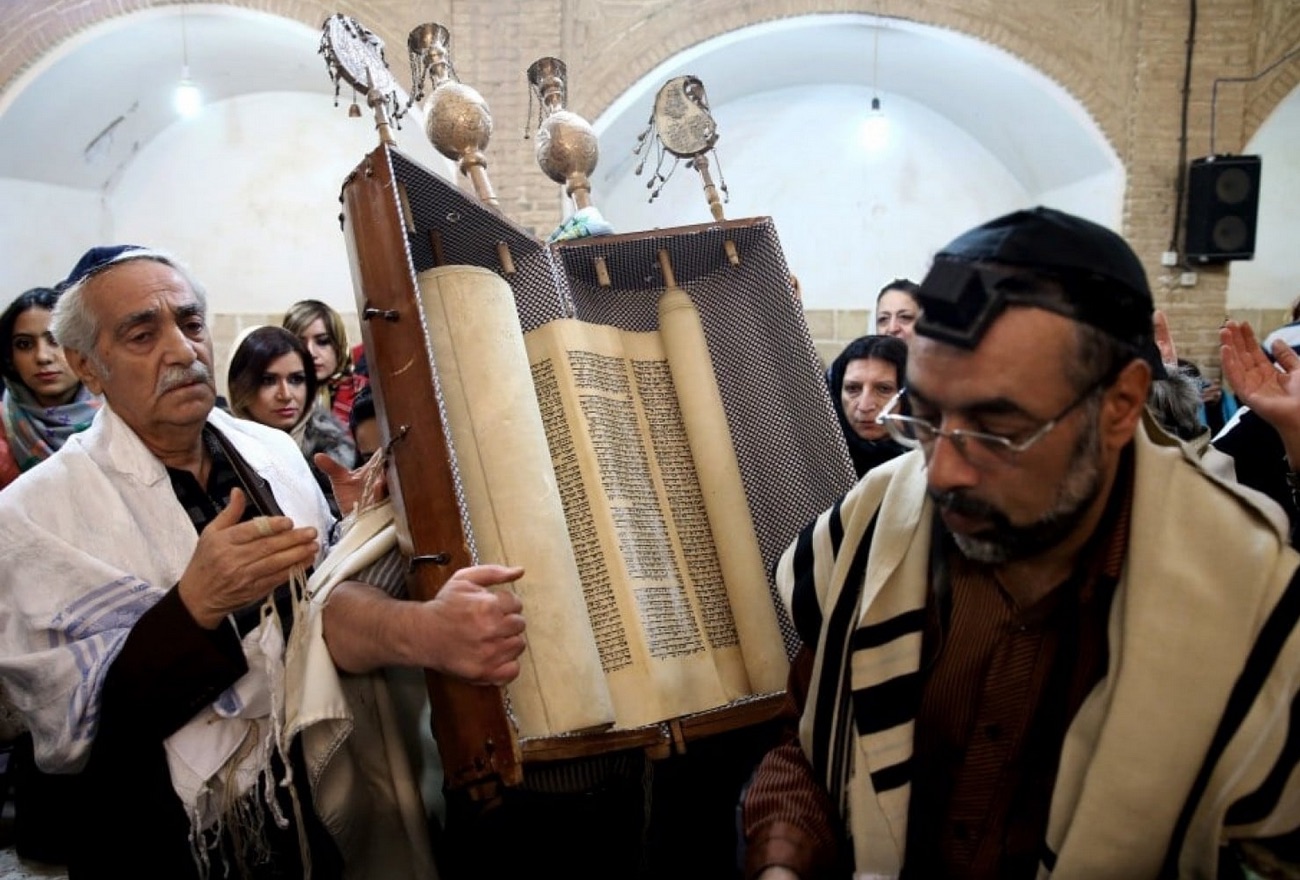The article below “Rabbinic Literature and Middle Persian Texts” by Yaakov Elman was originally published for the Encyclopedia Iranica in November 5, 2010. Kindly note that the images and accompanying captions do not appear in the Encyclopedia Iranica posting.
=======================================================================
Jews and Persians
Jews and Persians had coexisted in Mesopotamia, mostly peaceably, for some 700 years by the time that the first generation of prominent Babylonian talmudic rabbis was born in the third quarter of the 2nd century, some 60 years before the end of the Parthian dynasty in 224 CE. The Babylonian Jews would continue to live under Iranian rule for more than five centuries, including the entire period of the formation of the Babylonian Talmud (220-500 CE). The 1.8 million words of that talmud, twice the size of the Code of Justinian, provides us with a rich source for understanding the intellectual, cultural, and social life of the Jews of southern Mesopotamia during those three centuries, thus presenting a picture of the community’s close relationship with Middle Persian culture, and their social and intellectual contacts with their fellow citizens of the Persian Empire. As the late 3rd-century rabbi, Rabbi Huna, put it, the Babylonian “exiles” were at ease in Babylonia, as the other Jews in the Roman world were not (Menahot, fol. 110a). The feeling of being “at ease” was more than political. Even the Babylonian rabbis were highly acculturated and some participated in the theological debates that characterized the third and fourth centuries, especially on the burning issues of theodicy, the reliability of oral transmission, and the physical resurrection of the dead at the end of the time. It is noteworthy that, in regard to the last two issues, they found themselves on the same side with the Zoroastrian priests and against the Manichaeans. But it is becoming apparent that they felt at ease in a more personal way, in language and social relations, so much so that some Babylonian rabbis of the late third and fourth centuries felt compelled to discourage social relations between Jews and non-Jews. The ongoing nature of such legislation and anecdotes preserved in the Talmud itself indicate that this effort was far from totally successful (Elman, 2010).
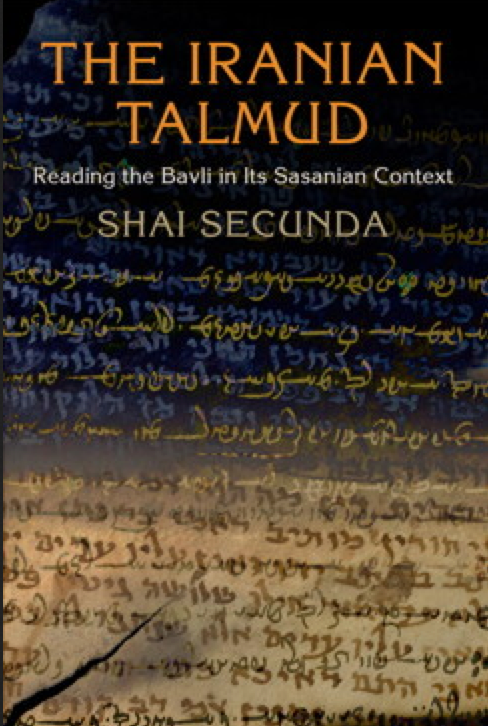
“The Iranian Talmud: Reading the Bavli in Its Sasanian Context” by Shai Secunda. Publisher: University of Pennsylvania Press (2013); Order: University of Pennsylvania Press, Amazon.
As far as their political ease, it is clear that the Iranian government wanted it that way. Jews were a significant minority (Neusner I, p. 15) in Mesopotamia, which was both the breadbasket of the empire and the province most vulnerable to Roman invasion. Unlike Christians, who might become a fifth column once Christianity became a tolerated religion in the Roman Empire in 313, the Jews would support the regime if they were left alone. That does not mean that there were not fanatic outbreaks on the part of Zoroastrian priests (Beer, pp. 25-32; Rosenthal, pp. 41-42), but the weight of evidence seems to point to a situation of comfort (Brody, pp. 52-62; Kalmin, pp. 121-48).
The official religion of the Persian Empire, Zoroastrianism, was also comfortable and even familiar to the Jews, with its theological doctrines of creation by the benevolent and omniscient Ohrmazd (see AHURA MAZDĀ), the fight against Evil, reward and punishment, heaven and hell, judgment, creation, the coming of three pivotal “messianic” figures, the ultimate defeat of Evil, the resurrection of the dead and the renewal of creation. This was true of its ethical system as well, with its emphasis on good thought, good speech, and good deed (humat, huxt, huwaršt), and its ritual system with its stress on the avoidance of idolatry, its hatred of sorcery, “wasting of seed,” and contact with menstruant women and dead bodies. Moreover, such staples of Zoroastrian thought, such as the importance of oral transmission of sacred texts and the authority of learned elites were shared by both sides. True, the operation of the sociological/psychological principle of the “narcissism of small differences” would have meant that leaders of both religions would have stressed their differences rather than similarities, but as the evidence indicates, Jewish acculturation to an Iranian way of life, mores, and culture was high. Some rabbis borrowed institutions from Sasanian law into their own legal system, transplants that took root, though sometimes not without resistance. However, the resistance was not rooted in the “foreign” origin of the borrowing, but rather in the need to smooth out the rough edges of the legal institution in its new context; this was particularly the case in regard to the question of returnable gifts and temporary marriage (Elman, 2008).
Nevertheless, despite the intensity of acculturation in the first half of the Sasanian era, it is becoming clear that this “golden age” lasted only a few centuries and that conditions changed with the reigns of Yazdegerd II (439-57) and Pērōz (459-84) (Neusner, V, pp. 60-69, but see Wiesehöfer, pp. 215-16). The attitude of the talmudic redactors (2nd half of the 5th century) toward Sasanian law, for example, turned sharply negative, but since their concern with the close relations between Jews and non-Jews continued, it is unlikely that the political changes obliterated social interactions. Given the hostility to Jews that Syriac Christian sources manifest, however, it would seem that the Jews were closer to Iranian Zoroastrians than they were to the Mesopotamian Christians, who advocated a religion that represented itself as Judaism’s replacement.

Iranian Jews praying during Hanukkah celebrations on Tuesday, December 27, 2011 at the Yousefabad Synagogue, in Tehran, Iran (Source: Wodu).
Religious ferment in the Sasanian Empire. We may gather from Kartīr’s inscriptions (see KARTĪR) that inter-religious dialogue and polemic were the order of the day, with Judaeo-Christian sects like the Elchasaites, among whom the founder of Manichaeism, Mani, was raised, Christian sects such as the Marcionites and, certainly, the Manichaeans and Nazarenes (Jones et al., IV, pp. 2595b-596b, s.v. Ebionites; VIII, pp. 5634b-5640b, 5702a-b). In eastern parts of the empire, Buddhism and Hinduism were also factors. According to Pahlavi sources, Šāpur II (r. 309-79) held religious disputations (Boyce, p. 118; Shaki, pp. 114-25, esp. p. 119). According to Manichaean accounts, at least, Šāpur I (r. 241-73) harbored Mani in his entourage, though his motives for doing so are unclear (Lieu, pp. 58-59; Neusner, II, pp. 16-18). Indeed, according to Shaul Shaked, it was precisely the encounter with Judaism and Christianity that turned Zoroastrianism into a more thoroughly dualistic religion (Shaked, 1993, pp. 10-13, 23-26).
In spite of persecution, Mani’s influence continued to grow, even in the Jewish community, as did that of the Sasanians’ rejuvenated Zoroastrianism (see below). This was especially true of Mahoza, or, as the Christians called it, Kokhe, a suburb of Ctesiphon, capital of the empire and its cultural and religious center. Mahozan Jews shopped for staples in Mahoza, but for luxury goods they crossed the Tigris and went “downtown” to Ctesiphon, so merchants were familiar with their signatures and seals (Gittin, fol. 6a); these shopping forays thus provided another venue for social interaction, as well as demonstrating their ease in this multi-ethnic metropolis. Mahoza itself also provided ample opportunities for social and theological interaction. The bishop of Ctesiphon resided in Mahoza/Kokhe, as did the Jewish exilarch; eventually, the “round city” became home to five major Christian churches.
As a cross-roads of religions, it is hardly surprising that Mahoza was home to many proselytes (Qiddushin, fol. 73a), and we may well expect a fair amount of interchange of a complex legal, ritual, or even theological ideas. As James Russell has observed, “influences from one quarter…do not preclude promiscuous intermingling with material from another tradition…; influences need not be a graft, but can be also a stimulus that brings into prominence a feature that had been present previously, but not important” (Russell, p. 6).
The Range of Acculturation
The Persian cultural presence within the Babylonian Jewish community will be assessed here in the domains of language, lifestyle, intellectual-methofological engagemant, ritual acculturation, and legal accomodation vis-à-vis the challenge of Sasanian law.
A. Language. Though Talmudic Aramaic contains less than 300 attested Iranian loanwords, Middle Persian was familiar to a few of not most prominent rabbis, who could understand it even if they were unable to read it (Gittin, fol. 19b), but the could pun in it (Yerushalmi Yoma 1:6; Megillah, fol. 11a). Most Mahozans, who shopped in Ctesiphon, must have used it to communicate there. Talmudic Aramaic contains loan-translations from Middle Persian, is influenced by its syntax (ō lō/lāas a reflex as ayāb nē, for example) and even its propensity to use the verb kardan(to do, to perform) in compounds asu hizzuq in place of the more naturally Semitic heheziqu (Bava metzia, fol. 55b; Elman, 2007b, p. 15).
B. Intimate lifestyle. Rabbinic attitudes toward sexuality seem to have been particularly susceptible to Iranian influence, though not when they contravened biblical norms. In this the rabbis themselves may represent the attitudes of their non-rabbinic fellow Babylonian Jews. In his study of rabbinic norms of sexuality, Michael Satlow observed that “Babylonian sources reflect much more complex, and conflicted, sexual assumptions than do Palestinian sources,” but also a more positive one (Satlow, pp. 175-83; Rubenstein, pp. 67-79, 147-54).
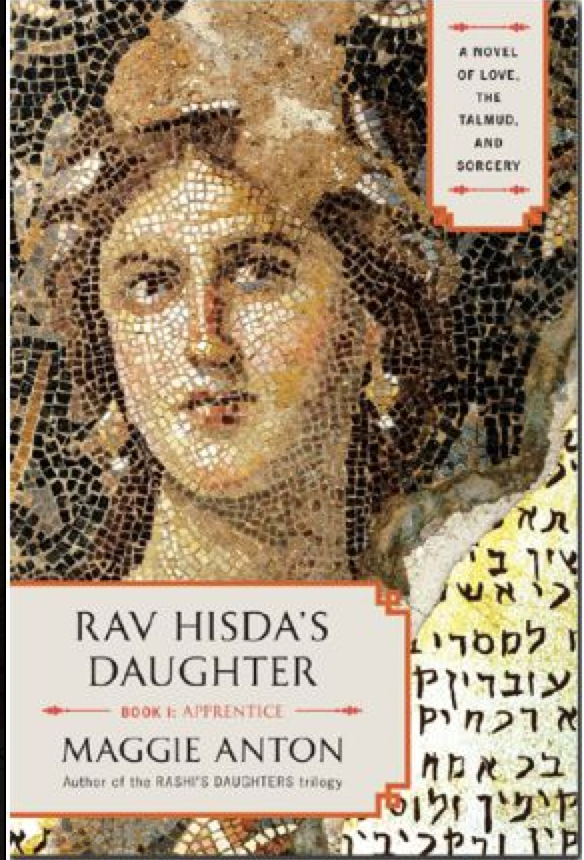
Maggie Anton‘s novel “Rav Hisda’s Daughter” (Published by Plume 2012 – order at Amazon). Anton’s novel narrates the story of the daughter of a Talmudic figure who lived in ancient Persia (Picture Source: The Unmasked Persona’s Review).
Middle Persian culture, at least as represented by Zoroastrian texts (in contrast to Manichaean and Christian texts), reveals a much more relaxed attitude toward sexual ethics than do Greco-Roman pagan, Christian, and classical Jewish texts. Adultery is not a capital crime for women. A fine of 700 drachmas is levied for adultery and 500 for abduction, while deflowering a minor carries a penalty of 600 drachma (Mādayān ī hazār dādistān 73:8-10; Macuch, 1993, pp. 489-90, 492; Perikhanian, pp. 180-81). Further, if a male accompanying a female to study religious texts at a Zoroastrian school seduces her, especially in an area in which the husband’s word carries weight, it is considered as though the man had done so under the husband’s orders or his implicit permission (Hērbedstān 6.7; Kotwal et al., pp. 44-45).
With this in mind, one can better understand why two prominent rabbis contracted temporary marriages in accord with the Sasanian institution. Thus, when away from home, Rabbi Nahman of Mahoza contracted such marriages in the first quarter of the 4th century, and Rav, who was born in the waning years of the Parthian regime, also contracted temporary marriages. Temporary marriage cannot be separated from the issue of polygyny, which was certainly permitted by the most influential Babylonian rabbis, although it was much less common, or approved of, in Roman Palestine (Schremer, pp. 181-223).
Thus, it would seem that, for Mahozan Jewish society, polygyny, temporary marriage, and the entrance of women into social relations are evidence of Iranian influence. Even their view of women’s strong sexual desires matched those of the neighboring Iranian cultures (Elman, 2003b, pp. 242-47). Again, Rava’s permissive stance in regard to daytime marital intercourse (Niddah, fol. 17a) had a Zoroastrian demonological belief at its base, as did the Talmud’s suggestion that nail-parings should be buried (Williams, II, pp. 61-62; Gafni, 1990, p. 171; Elman, 2007a, pp. 141-44; idem, 2007c, p. 179; Vidēvdād, chap. 17).

The West Wall in Jerusalem. After his conquest of Babylon, Cyrus the Great allowed the Jewish captives to return to Israel and rebuild the Hebrew temple. It is believed that approximately 40,000 did permanently return to Israel (Photo source – see Blog).
Iranian attitudes predominated in more personal matters. For example, both Rabbis Nahman and Rava had a fear of death, of the process of dying, which was (wrongfully) considered painful (Moed qatan, fol. 28a). This is in line with the Zoroastrian attitude as expressed in Dēnkard 21: “the soul of the righteous undergoes much pain when it departs from the world; until it has passed through that frightful account, it laments” (Jaafari-Dehaghi, pp. 78-79). These anecdotes reflect an attitude to death on the part of Babylonian rabbis very different from those attributed to the sages of Roman Palestine (Ketubot, fol., 77b; Elman, 2004a). Again, Rabbi Nahman is reported to have told his daughters regarding the killing of lice: “Kill the hated ones and let me hear the sound!” (Shabbat, fol. 12a), quite like a Zoroastrian, for whom the killing of noxious beasts and insects was a good deed (kirbag; Elman, 2007c, p. 173; Moazami, 2005).
The Kulturkampf: Mahoza and Pumbedit. Among the many anecdotes preserved in the Babylonian Talmud are some that reveal the social tensions that roiled Babylonian Jewish society, and, at times, its relations with outsiders. For example, it is clear from an account of a confrontation between Rabbi Yehuda, founder of the Pumbedita Yeshiva about 100 km from the capital, and Rabbi Nahman, who in that story represents the quintessential Persianized Mahozan Jewish aristocrat, that the degree of acculturation of the middle classes probably differed from that of the wealthy and well-connected. Rabbi Nahman is mentioned more than 1500 times in the Talmud, and we can draw a fairly detailed picture of his views on many issues. Thus, he was strongly loyal to the Sasanian regime; he named one of his daughters Dēnāg (Qiddushin, fol. 70b), apparently after the name of several Sasanian queens, while his disciple Rava (mentioned some 3800 times in the Talmud, and who was of middle-class origins) criticized the regime with the words that “we are still the slaves of Ahasuerus” (i.e., Xerxes, the Achamenid king). Rabbi Nahman looked upon the Jewish holiday of Purim in more positive terms (Megillah, fol. 14a); in his lifestyle he was thoroughly Persianized. He contracted temporary marriages when away from home (Yoma, fol. 19b; Yevamot, fol. 37a), traveled in a gilded sedan chair (gōharqa, cf. Armenian gahaworak, litter, MP gāhwārag, “cot, cradle”; Gittin, fol. 31b), a practice that his disciple Rava, who was of middle class origins, adopted when he became wealthy (Bava metzia, fol. 73b); served his guests citrons, the royal fruit (see below); he used Persian terms rather than rabbinic or Aramaic ones (see below); he allowed the women of his household a degree of freedom that more conservative rabbis disapproved of (see below). Thus, a story (Qiddushin, fol. 70a-b) has Rabbi Yehudah criticize him for the latter two habits. He is criticized for his elitist, Iranicized language (the use of words such as atrunga
It is noteworthy, however, that Rabbi Nahman is not criticized for contracting temporary marriages, a practice adopted by Samuel’s colleague Rav, a precedent that may have protected Rabbi Nahman from censure. The criticisms of upper-class lifestyle, however, did not end with Rabbi Nahman himself; they continued with his family, especially Yalta, who is described as high-handed and proud (Berakhot, fol. 51a), as well as timorous and desirous of her comfort (Bezah, fol. 25b). His daughters are depicted and condemned for not being particularly eager to be rescued from captivity among gentiles with its concomitant danger of rape (Gittin, fol. 45a).
The narrator reveals a large degree of cultural and linguistic sophistication. He distinguishes three registers of rabbinic, popular, and elitist in Hebrew and Aramaic, and knows that atrunga (MPers. wādrang) and anbag (MPers. anāpak) are Middle Persian loanwords. Clearly, this was one of the defining issues of his world, as important to him as the question of the mingling of the sexes (compare a similar theme in Shabbat, fol. 32a). This story allows us to trace a Kulturkampfwithin rabbinic circles in Babylonian Jewish society, since Rabbi Nahman is condemned by the use of cultural stereotypes. The Talmud associates both Persians (Shabbat, fol. 94a) and the Jewish Persianized elite with arrogance, a charge echoed for the Persians by Procopius (History of the Wars, passim). The Talmud also mocks the practice of kin-marriage (xwēdōdāh; Yevamot, fol. 97a-b), but the story is not an all-out attack on Iranian lifestyle, but rather a critique of a specific type of aristocratic adaptation to it, that is, the upper-class Mahozans (Elman, 2007c, pp. 173-75).

The tomb of Esther and Mordechai in Hamedan, northwest Iran. External view (left) and the interior of the tomb (right).
Rav, however, was apparently immune from this criticism, though he is reported to have been a “friend” of Artabanus/Ardawān V, the last Parthian king (Avodah zarah, fols. 10b, 11a). He quotes a Zoroastrian theological statement on fate (see below) and advises against traveling by night out of fear of demons (Bava qamma, fol. 60b). Given all of this, the statement attributed to him (Shabbat, fol. 75a) that it is forbidden to learn from a mage (magus) may be part of the same Kulturkampf, and authentically Rav’s. Still, Rav may have seen this as a neutral element of the common Iranian-Mesopotamian culture rather than a specifically religious teaching. This also sheds light on the pervasiveness of Jewish acculturation; even Zoroastrian theological teachings were transmuted into neutral “knowledge.”
As to the non-elitist Babylonian Jews, we have a report regarding the ordinary Babylonian Jewish women. Rabbi Zera reports that the “daughters of Israel had undertaken to be so strict with themselves as to wait for seven [clean] days [after the appearance] of a drop of blood the size of a mustard seed [although biblically they are required only to separate for seven days from the onset of menstruation]” (Berakhot, fol. 31a; Megillah, fol. 28b; Niddah, fol. 66a). It is clear from Niddah (fol. 66a) that this stringency was a popular practice and not a rabbinic prohibition, probably in response to a “holier than thou” attitude perceived by the populace as emanating from their Persian neighbors. It seems that Babylonian Jewish women had internalized their Zoroastrian neighbors’ critique of Rabbinic Judaism’s relatively “easy-going” ways in this regard; Jewish women did not have to remain isolated on spare rations in a windowless hut for up to nine days, as was prescribed in Pahlavi Vendidād (Elman, 2004a, p. 34; but see Secunda, 2007a, pp. 144-89).
C. Intellectual-theological engagement. The question concerns engagement with Persian tradition on matters such as the authority and authenticity of rabbinic or Zoroastrian oral tradition, the issue of theodicy (a burning issue for nearly all Sasanian religions), the question of the nature of the future resurrection of the dead, where Manichaeism denied physical resurrection, in contrast to Zoroastrianism, Judaism, and Christianity, and the relation of outsiders (non-Zoroastrians to Zoroastrians and non-Jews to Jews) to the system of corpse-impurity, an issue over which the Zoroastrian and rabbinic elites were divided around the turn of the 5th century.
(a) Authority and authenticity of oral tradition. Fourth-century rabbinic sages faced theological challenges not only from Zoroastrianism, the state religion, but also from Manichaeism, a religion without state support, regarding which the Jewish rabbis and the Zoroastrian magi were on the same side.
In this environment, one can appreciate why Rava shows a deep sensitivity to the problems of rabbinic biblical exegesis. In an astounding statement, Rava privileges rabbinic oral teaching over Scripture (Eruvin, fol. 21b) and elsewhere argues that the rabbis’ decisions are more authoritative than Scripture itself, because they control its interpretation (Makkot, fol. 22b). He is one of only two Amoraim to whom the principle that “a verse does not depart from its plain sense” is attributed. He was sharply attentive to the problems involved in the study of legal biblical exegesis (Elman, 2003a, pp. 1854-55; idem, 2004a, pp. 38-43; Yevamot, fol. 11b).
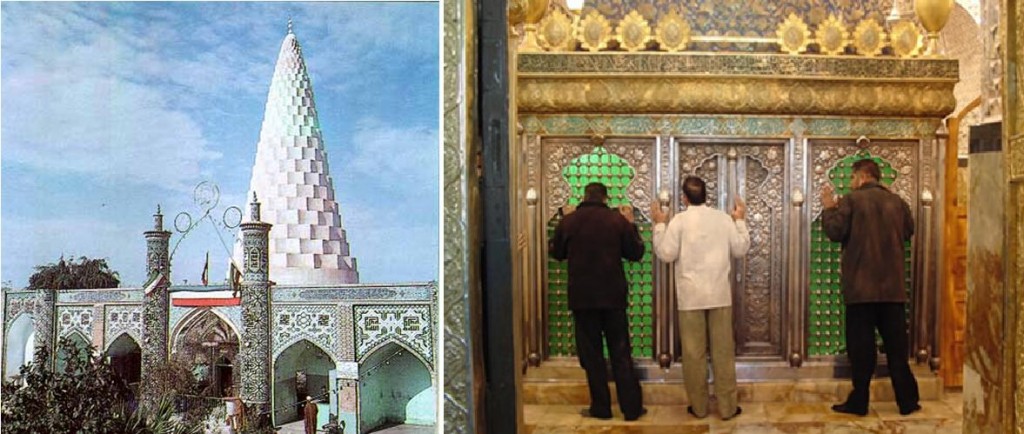
The tomb of Daniel in Khuzestan in southwest Iran. The main structure (note cone-like dome) as it stands today (left) and Iranian pilgrims paying homage within the tomb of Daniel.
Ideally, a written form is the proper venue for the transmission of law; why then is the law of the Rabbis unwritten? Rava (Eruvin, fol. 21b) responds to this problem by quoting Ecclesiastes 12:12, “Of the making of books there is no end,” that is, rabbinic law is too voluminous to be reduced to writing. It is pertinent to recall that the largest Middle Persian compilation known to us is the Dēnkard, which runs to only 169,000 words (Cereti, p. 41). In contrast, the greatest compilation of Roman law, Justinian’s Digest of 534 CE, weighs in at about one million words, while the Talmud runs to 1,836,000 words. Based on a large ancient, probably eighth-century fragment of Talmud published a decade ago (Elman, 1999, pp. 74-75), which contained an average of 576 words per column, and assuming a Torah scroll-sized scroll as standard, it would have taken about ten and a half scrolls of that size for 2,522 columns. Aside from the technical problems, however, one must also note that Rava’s statement can be seen as a response to Mani’s critique of oral transmission.
As Jes Asmussen commented, “[Mani’s] immense confidence in the written tradition was something quite exceptional in the history of antiquity that never questioned the reliability and security of the oral tradition. … And, to take just one more example, the Dēnkard without hesitation states that the living spoken word is much more important than the written one” (Asmussen, p. 16; see Elman, 2007c, p. 178). Rabbi Nahman, Rava’s master, also faced the challenge of dualists of some sort, presumably Jewish, Christian, or Jewish-Christian Gnostics. He is reported as having warned that whoever can respond to the “heretics” (probably a Christian sect) as Rabbi Idit could, should respond; otherwise, he should not (Sanhedrin, fol. 38b). It may be that he considered himself as one of those unfit to respond.
(b) Resurrection of the dead. The extensive space given in the Talmud (Sanhedrin, fols. 90b-91b) to proving that resurrection of the dead is a biblically mandated doctrine, as well as Rava’s attributing its denial to Job (Bava batra, fol. 15a), in contrast to the Yerushalmi’s glancing treatment of the issue, may be due to the challenge of the Manichaean denial of resurrection of the body while affirming the resurrection of the soul (Sundermann, pp. 749-60).
(c) Theodicy. Rava’s statements regarding the problem of theodicy also address a troubling issue for everyone. Given the centrality of the problem of Evil in Zoroastrianism, indeed in all the religions of Late Antiquity, it is easy to see why Rava was so concerned with it, and why Rabbi Yosef in the generation before devised a theology of divine anger that acts independently of His will, apparently based on the demon Wrath (Xešm) in Zoroastrianism (Bava qamma, fol. 60a; Avodah zarah, fol. 4b). One of Rava’s most radical statements fits perfectly within the context of the Middle Persian debate on “fate” and “works,” and is almost certainly an Aramaic translation of the Middle persian zan ud frazand ud xwāstag ud xwadāyīh ud zīndagīh pad baxt (wife, and offspring, and property, and authority, and living by fate), which appears in Pahlavi Vendidād (5.9) and parallels (Dēnkard, pp. 174-75; Vidēvdād, p. 100; Zaehner, pp. 400-18; Elman, 2004a, pp. 50-52). In good Semitic fashion Rava selects three of them, namely offspring, life-span, and sustenance to astrology (Moed qatan, fol. 28a). His great-grandfather-in-law, Rav, selects wife and property (expressed as house and field, making up the number three (Sotah, fol. 2a), and authority was mentioned by Rav’s son-in-law (Berakhot, fol. 58a). Thus all five elements of the Zoroastrian saying appear in the Talmud.
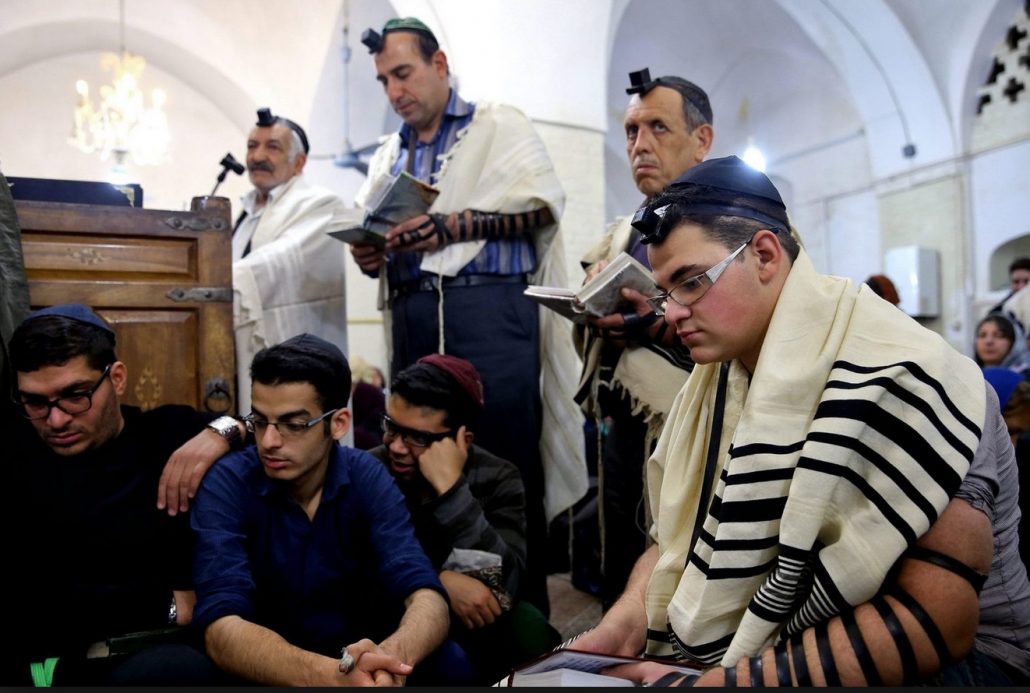
Iranian Jews in a Synagogue in Tehran in the Fall of 2016 (Source: AIC).
D. Ritual acculturation, especially stringencies regarding menstrual impurity, the ritual use of a belt by Babylonian Jews, prospective and retrospective impurity and similar technical matters. Mention has already been made of one significant example of the influence of Zoroastrian ritual norms on the ordinary Jewish Babylonian woman and, perforce, the Babylonian man who could not have been happy about the additional week of abstinence. This indicates just how much the values of the surrounding culture had been internalized into the Jewish value system. Clearly, both sexes must have felt the force of the “holier than thou” argument.
When it comes to codification and analysis of rituals, we enter an even more complex area, one in which we may discern a welter of influences and counter-influence in both directions. Some points are clear; for example, it has long been apparent that the Talmud’s recommendation regarding the disposal of fingernail parings in Niddah, (fol. 17a) has a Zoroastrian origin. Another significant sign of acculturation is the adoption of the belt (Hebrew avnet, Aramaic hemyana, MP kustīg) by all sectors of Babylonian Jewish society, to the point that wearing a belt was considered a preparation for prayer (Shabbat, fol. 9b; Zevahim, fol. 19a; Elman, 2007c, pp. 181-82).
Michael Satlow has pointed out that the rabbinic emphasis on the severity of the sin of emitting seed vainly (hotzaʾat zerʿa le-vattalah) is due to the work of the editor and redactor(s) of Niddah (fol. 13a-b). He suggested that “perhaps they adopted this concept from Zoroastrian notions, to which, we may assume, they were exposed” (Satlow, 1995b, pp. 137-75). This involves the question of rabbinic and Zoroastrian system of purities. Unfortunately, detailed comparisons will only be possible when significant Zoroastrian texts, especially Pahlavi Vendidād, are critically edited and analyzed. In the meantime, one may only make some general observations. The two systems, first of all, operate with similar basic concepts, including human corpses (tumʾat met), dead animals (tumʾat nevelah, both nasā “corpse, carrion” in MP), and a menstruant woman (niddah, MP zan ī daštān), all of which are considered sources of impurity. Because the basic biological processes that both systems must deal with are identical, though their construction of impurity may be different, the resulting systems will be sufficiently close to warrant extended comparative study. This is particularly important because the Zoroastrian system, while employing an elliptical style similar to rabbinic texts, lacks any medieval commentaries and comprehensive works for the elucidation of rabbinic discussions.
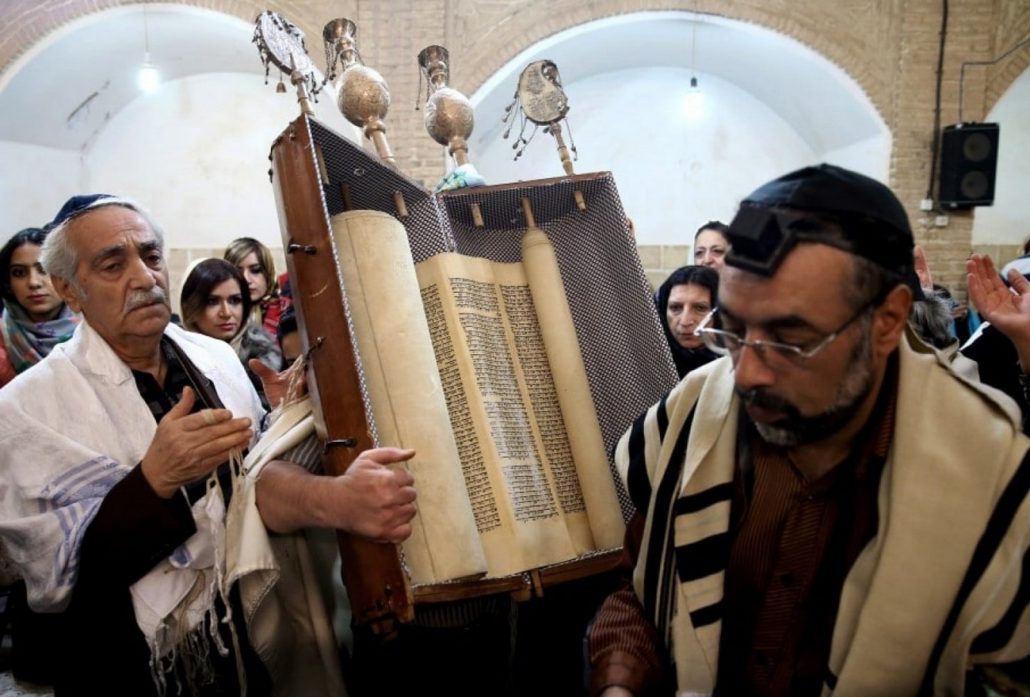
The above photo taken on November 20, 2014, was featured in an article by Ishaan Tharoor in the Washington Post entitled “Iran unveils a memorial honoring Jewish heroes” (December 18, 2014). As noted by Ishaan Tharoor, the above shows an Iranian Jewish man holding a Torah scroll at the Molla Agha Baba Synagogue, in the city of Yazd 420 miles (676 kilometers) south of capital Tehran, Iran (Photo: Washington Post & Ebrahim Noroozi/AP). It would appear that, excluding exceptions such as the Washington Post’s Ishaan Tharoor, reports and images such as the above are routinely ignored by mainstream Western press and media.
Both systems struggled with the problem of defining the onset and limiting the extent to which impurity may be said to exist. Impurity held much more serious consequences for the Zoroastrians, since, theologically, impurity was a weapon of Ahriman, while, for the rabbis, impurity was a strictly technical category. Thus, Ohrmazd rejects extending the range of impurity, “for if these corpses, namely, dog-borne, bird-borne, wolf-borne, wind-borne, and fly-borne, were to make a man guilty, right away my entire existence with bones…every soul would be shuddering (in anger and fear), every body would be forfeit, by the large amount of these corpses which lie dead upon this earth” (Vidēvdād 5.4). It would seem that this passage sparkled questions on the part of Mahozan rabbis, problems that the rabbinic system lacked the sources to answer (Bava batra, fol. 22a; Menahot, fol. 69a-b; Bezah, fol. 7a; Eruvin, fol. 104b).
E. Legal accommodation. The issue of legal accommodation presents itself as rabbinic sages meet the challenge of Sasanian law and the government-sponsored law courts, adopt a Sasanian legal institution, and promulgate legal decisions that were untouched by such considerations but shed light on the common ambient culture. It does not concern domains such as magic, folklore, or any ordinary elements of daily life, because these influences are to be expected even in the absence of intense acculturation (Gafni, pp. 161-76; Bohak, pp. 406-25, Shaked, 1985; idem, 1994; idem, 2003; Kiperwasser and Shapira; Herman, 2008).
(a) Parallels and convergences: The rabbinic category of the “rebellious wife” (moredet; Ketubot, fol. 62a-62b) finds its exact counterpart in atarsāgāyīh, “insubordination,” to which an entire chapter of Mādayān ī hazār dādistān (5:6-8) is devoted, with similar definitions and penalties. In this case, as in others, the differences are sometimes as illuminating as are the similarities. The rabbinic concept of onaʾah, “overreaching” in sales, may be paralleled by Mādayān ī hazār dādistān (37:2-10), with the same three-day period stipulated and a similar profit-margin (Bava metzia, fols. 49b-50a, 69a). Then there is the institution of meʾun (refusal), whereby a underage girl could be married off by her mother or brothers, but could, upon reaching her majority, leave her husband (Mishnah yevamot 13:1, 4, 7; Yevamot, fol. 107a; for the parallel, see Mādayān 89:15-17).
Some parallels involve matters with which every legal system must deal. Similar economic, social, and religious conditions produce similar concerns, but studying each one in isolation precludes gaining a complete picture of the conditions under which each system developed, and the way that each responded to common problems. It is likely that the rabbis and the Iranian jurisconsults were faced with a rash of fraudulent land-sales, with people claiming to own the land they did not, as evidenced by Bava metzia (fol. 14a-b) and Mādayān ī hazār dādistān (8:13-9:5), and due to the hunger for arable land in Jewish Babylonia (because of the density of population) and Iran (because of the arid conditions of its plateaus and mountains; Elman, 2004b, pp. 101-2).
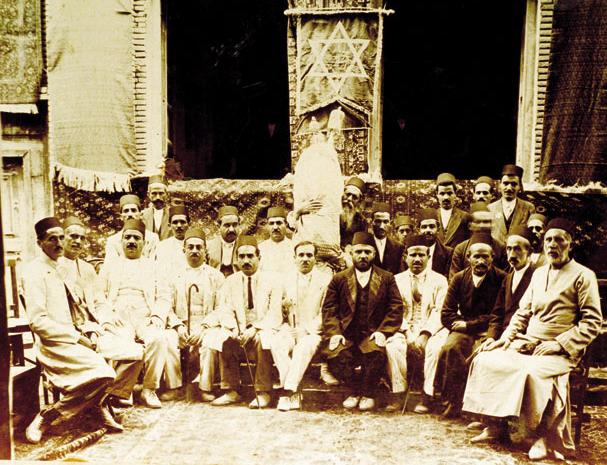
Portrait of Iranian Jews in the city of Hamedan in 1918 (Source: Public Domain and originally from National Library of Iran).
(b) Samuel’s dictum that “the [civil] law of the government is [valid] law” (Nedarim, fol. 28a; Gittin, fol. 10b; Bava qamm, fol. 113a; see especially, Bava batra, fol. 54b) indicates that, already early on in the Sasanian period, one of the greatest Babylonian rabbinic authorities was willing to come to terms with the new regime and its legal system. This attribution is confirmed by his ruling regarding land tenure along the river banks near Nehardeʿa, his hometown.
(c) Land tenure and private “eminent domain.” Rabbinic law recognizes the right of eminent domain provided to partners who dig a canal to the depth of a “horse’s neck.” Although the legal and public policy issues are too complex to discuss here, it is clear that the rabbis were quite aware of Sasanian law and legal terminology (MP gōš bālāy, Aramaic maya ad meloʾ tzavarei susya, which complement each other and cannot be understood fully in isolation (see Mādayān 85:8-11; Elman, 2004b, pp. 102-49).
(d) Conditional and returnable gifts. As noted above, Rabbi Nahman contracted temporary marriages and also introduced the Sasanian institution of temporary or conditional “ownership” in his legal decisions (Bava batra, fol. 137b), especially in the area of ritual law (Elman, 2008, pp. 150-95).
(e) Meeting the competition of Persian courts. According to earlier rabbinic law, when a donor who had made a gift in contemplation of death unexpectedly recovered, he could not regain his property, something the Persian courts would allow. It is important to note that Rabbi Nahman modified these earlier rules so as to make abandoning rabbinic law in favor of a resort to a Persian court less advantageous to such recovered donors (Yaron, 1980, pp. 85-89). In the Talmud, his explicit references to “Persian law” are always interpreted negatively (Bava batra, fol. 173a-b; Bava qamma, fol. 58b; Shevuot, fol. 34b), but these seem to reflect the views of Babylonian Talmud’s late 5th-century redactors living with anti-Jewish decrees; it is unlikely that he expressed these negative and inaccurate views. For example, it is clear that Persian law did not obligate a surety to pay the lender even when the borrower was solvent (as Bava batra, fol. 173b, would have it; see Mādayān 57:2-12), because no one would agree to be a surety under such circumstances, thus shutting off the flow of credit. Abaye’s (d. 338) more nuanced comments regarding the Persian courts in Gittin (fol. 28b) are thus more accurate, as is his knowledge of Persian legal terminology (pursišn-nāmag, see Bava batra, fol. 173b; Mādayān 34:6; Elman, 2006c, pp. 31-55).
(f) Keeping estates together. Study of Sasanian law may be helpful in placing rabbinic legislation in its proper context in a broader sense. John A. Crook (p. 118) observed that no fewer than eleven of the books of Justinian’s Digest are devoted to questions of succession and inheritance. Likewise, a third of the folios of the Mādayān ī hazār dādistān (Book of a thousand judgements), the only Sasanian law book that has reached us, contain mentions of stūrīh (trusteeship). In contrast, the rabbinic parallel to the Sasanian law book, the Mishnah, devotes only two of its 530 chapters to the subject of inheritance, and very little of the rest. Moreover, it is clear that the Talmuds’ attention is devoted to the family farm and not large estates. The difference in social policy and class interest could not be more striking. However, in one striking instance, Rabbi Nahman takes the Sasanian landowners’ point of view (Bava batra, fol. 13a-b; Elman, 2007d, pp. 85-86).
Conclusion
The evidence cited here, and more in the studies on which it is based, indicates that Middle Persian attitudes and doctrines made inroads in many areas of Babylonian rabbinic culture, in law, in theology, and in general cultural attitudes. This is all to be expected, not only because of their long, relatively peaceful sojourn in Mesopotamia, but also because Zoroastrianism was a more benign presence than either Roman paganism or Christianity. Its theological and ritual structure was more in tune with that of Rabbinic Judaism than Roman paganism was, and while it shared an expectation of a messianic advent with Judaism, that advent was in the future, and therefore not a subject for acrimonious debate as it was with Christianity.
Bibliography:
Ādurbād Ēmēdān, Dēnkard, tr. Shaul Shaked as The Wisdom of the Sasanian Sages (Dēnkard VI) by Aturpāt-i Ēmētān, Boulder, Col., 1970.
Behramgore T. Anklesaria, transc. and tr., Pahlavi Vendidâd (Zand-î Jvît-Dêv-Dât), ed. Dinshah D. Kapadia, Bombay, 1949.
Jes Peter Asmussen, Manichaean Literature: Representative Texts Chiefly from Middle Persian and Parthian Writings, Delmar, New York, 1975.
Mosche Beer, “The Decrees of Kartir on the Babylonian Jews,” Tabriz 54, 1982, pp. 536-39.
Gideon Bohak, Ancient Jewish Magic: A History, Cambridge, 2008.
Mary Boyce, Zoroastrians: Their Religious Beliefs and Practices, London, 1979.
Robert Brody, “Judaism in Sasanian Babylonia: A Case Study in Religious Coexistence,” in Shaul Shaked and Amnon Netzer, eds., Irano-Judaica: Studies Relating to Jewish Contacts with Persian Culture throughout the Ages II, Jerusalem, 1990, pp. 52-62.
John A. Crook, Law and Life of Rome, 90 B.C.-A.D. 212, Ithaca, 1967.
Carlo G. Cereti, La Lettaratura Pahlavi: Introduzione ai testi con riferimenti alla storia degli studi e alla tradizione manoscritta, Milan, 2001.
Dēnkard, see Ādurbād Ēmēdān.
Yaakov Elman, “Orality and the Redaction of the Babylonian Talmud,” OralTradition 14/1, 1999, pp. 52-99.
Idem, “Classic Rabbinic Interpretation,” Jewish Study Bible, Oxford and New York, 2003a, pp. 1844-862.
Idem, “Marriage and Marital Property in Rabbinic and Sasanian Law,” in Catherine Hezser, ed., Rabbinic Law in Its Roman and Near Eastern Context, Tübingen, 2003b, pp. 227-76.
Idem, “Acculturation to Elite Persian Norms in the Babylonian Jewish Community of Late Antiquity,” in Ephraim B. Halivni, Zvi A. Steinfeld, and Yaakov Elman, eds., Netiʾot David: sefer ha-yovel le-David ha-Livni: Jubilee volume for David Weiss Halivni, Jerusalem, 2004a, pp. 31-56.
Idem, “Up to the Ears, in Horses’ Necks: On Sasanian Agricultural Policy and Private ‘Eminent Domain’,” Jewish Studies: An Internet Journal 3, 2004b, 95-149.
Idem, “R. Yosef in a Period of Divine Anger (Hebrew),” Annual of Bar-Ilan University: Studies in Judaica and the Humanities 30-31: In Memory of Professor Meyer Simcha Feldblum, Ramat Gan, Israel, 2006a, pp. 93-104.
Idem, “Scripture Versus Contemporary Needs: A Sasanian/Zoroastrian Example,” Cardozo Law Review 28, 2006b, pp. 153-69.
Idem, “The Babylonian Yeshivot in the Amoraic and Post-Amoraic Era [Functioning as Courts] (Hebrew),” in Emmanuel Etkes, ed., Yeshivot and Batei midrash, Jerusalem, 2006c, pp. 31-55.
Idem, “‘He in His Cloak and She in Her Cloak’: Conflicting Images of Sexuality in Sasanian Mesopotamia,” in Rivka Ulmer, ed., Discussing Cultural Influences: Text, Context, and Non-Text in Rabbinic Judaism: Proceedings of a Conference on Rabbinic Judaism at Bucknell University, Lanham, Maryland, 2007a, pp. 129-64.
Idem, “A Tale of Two Cities: Mahoza and Pumbedita (Hebrew),” in David Golinkin et al., eds., Essays in Jewish Studies in Honor of Prof. Shamma Friedman, Jerusalem, 2007b, pp. 3-38.
Idem, “Middle Persian Culture and Babylonian Sages: Accomodation and Resistance in the Shaping of Rabbinic Legal Tradition,” in Charlotte Elisheva Fonrobert and Martin S. Jaffe, eds., Cambridge Companion to the Talmud andRabbinic Literature, Cambridge and New York, 2007c, pp. 165-97.
Idem, “The Socioeconomics of Babylonian Heresy,” in Alyssa Gray and Bernard Jackson, eds., Jewish Law Association Studies XVII: Studies in the Mediaeval Halakhah in Honor of Stephen M. Passamaneck, 2007d, pp. 80-126.
Idem, “Who Were the Kings of East in West in Ber 7a?: Roman Religion, Syrian Gods and Zoroastrianism in the Babylonian Talmud,” in B. Bar-Kochba, S. J. D. Cohen, and J. Schwartz, eds., Judaism in the Ancient World, Leiden, 2007e, pp. 43-80.
Idem, “Returnable Gifts in Rabbinic and Sasanian Law,” in Shaul Shaked and Amnon Netzer, eds., Irano-Judaica VI, Jerusalem, 2008, pp. 150-95.
Idem, “The Other in the Mirror: Iranians and Jews View One Another: Questions of Identity, Conversion and Exogamy in the Fifth-Century Iranian Empire,” in Carol Altman Bromberg, Nicholas Sims-Williams, and Ursula Sims-Williams, eds., Iranian and Zoroastrian Studies in Honor of Prods Oktor Skjærvø, Bulletin of the Asia Institute 19-20, 2009-10.
Idem, “Safron, Spices, and Sorceresses: Magic Bowls and the Bavli,” in Kimberly Stratton and Dayna Kalleres, eds., Daughters of Hecate: Women and Magic in Antiquity (forthcoming).
Idem, The Hērbedestān in the Hērbedestān: Priestly Teaching from the Avesta to the Zand,” in Shaul Shaked and Amnon Netzer, eds., Irano-Judaica VII (forthcoming).
Idem, “Toward an Intellectual History of Sasanian Law: An Intergenerational Dispute in Hērbedestān 9 and Its Rabbinic Parallels,” in Carol Bakhos and Rahim Shayegan, eds., The Talmud in its Iranian Context, Tübingen, 2010, pp. 21-57.
S. Y. Friedman, “An Ancient Scroll Fragment (BHul 101a-105a) and the Rediscovery of the Babylonian Branch of Tannaitic Hebrew,” Jewish Quarterly Review 86, 1995, pp. 9-50.
Isaiah Gafni, Yehude Bavel bi-tekufat ha-Talmud: haye ha-hevrah veha-ruah (The Jews of Babylonia in teh Talmudic Era: A Social and Cultural History), Jerusalem, 1990.
Hērbedestān, see Kotwal et al.
Geoffery Herman, “The Exilarchate in the Sasanian Era,” Ph. D. diss., Hebrew University, 2005.
Idem, “The Story of Rav Kahana (BT Baba Qamma 117a-b) in Light of Armeno-Parthian Sources,” in Shaul Shaked and Amnon Netzer, eds., Irano-Judaica VI, 2008, pp. 53-86.
Mahmoud Jaafari-Dehaghi, Dādestān ī dēnig: Transcription, Translation and Commentary, Paris, 1998.
Lindsay Jones, Mircea Eliade, and Charls Adams, eds., Encyclopedia of Religion, 2nd ed., 15 vols., Detroit, 2005.
Reuven Kipperwasser and Dan Shapira, “Irano-Talmudica I – The Three-legged Ass and ‘Ridy’ in B. Taʾanith: Some Observations about Mythic Hydrology in the Babylonian Talmud and in Ancient Iran,” Association for Jewish Studies Review32, 2008, pp. 101-16.
Firoze M. Kotwal, Philip Kreyenbroek, and James R. Russell, The Hērbedestān and the Nērangestān I: Hērbedestān, Studia Iranica 10, Paris, 1992.
Samuel N. C. Lieu, Manichaeism in the Later Roman Empire and Medieval China: A Historical Survey, Manchester, 1985.
Maria Macuch, Das sasanidische Rechtsbuch “Mātakdān i Hazār Dātistān” (Teil II), Deutsche Morgenlädische Gesellschaft, Wiesbaden, 1981. Idem, Rechtskasuistik und Gerichtspraxis zu Beginn des siebenten Jahrhunderts in Iran: Die Rechtssammlung des Farrohmard i Wahrāmān, Wiesbaden, 1993.
Idem, “Iranian Legal Terminology in the Babylonian Talmud in the Light of Sasanian Jurisprudence,” in Shaul Shaked and Amnon Netzer, eds., Irano-JudaicaIV, 1999, pp. 91-101.
Idem, “The Talmudic Expression ‘Servant of the Fire’ in the Light of Pahlavi Legal Sources,” in Studies in Honor of Shaul Shaked, Jerusalem Studies in Arabic and Islam 26, 2002, pp. 109-29.
Idem, “On the Treatment of Animals in Zoroastrian Law,” in Alois van Tongerloo, ed., Iranica Selecta: Studies in Honor of Professor Wojciech Skalmowski on the Occasion of His Seventieth Birthday, Silk Road Studies VIII, Turnhout, 2003, pp. 167-90.
Idem, “An Iranian Legal Term in the Babylonian Talmud and in Sasanian Jurisprudence: dastwar(īh),” in Shaul Shaked and Amnon Netzer, eds., Irano-Judaica VI, Jerusalem, 2008.
Idem, “The Hērbedestān as a Legal Source: A Section on the Inheritance of a Convert in Zoroastrianism,” in Carol Altman Bromberg, Nicholas Sims-Williams, and Ursula Sims-Williams, eds., Iranian and Zoroastrian Studies in Honor of Prods Oktor Skjærvø, Bulletin of the Asia Institute 19, 2009.
Idem, “Allusions to Sasanian Law in the Babylonian Talmud,” in Carol Bakhos and Rahim Shayegan, eds., The Talm ud in its Iranian Context,, Tübingen, 2010, pp. 178-205
Mādayān ī hazār dādistān, see Perikhanian.
Mahnaz Moazami, “Evil Animals in the Zoroastrian Religion,” in History of Religions 44/4, 2005, pp. 300-17.
Idem, ed. and tr., Pahlavi Vidēvdād (forthcoming).
Jacob Neusner, A History of the Jews in Babylonia, 5 vols., Leiden, 1965-70.
Anahit Perikhanian, tr., The Book of A Thousand Judgements: A Sasanian Law-book, tr. Nina Garsoian, Costa Mesa, California, 1997.
E. S. Rosenthal, “For the Talmudic Dictionary,” Irano-Talmudica, Jerusalem, 1982, pp. 13-38 (in Hebrew with Hebrew numbering).
Jeffrey L. Rubenstein, The Culture of the Babylonian Talmud, Baltimore: 2003.
James R. Russell, “Ezekiel and Iran,” in Shaul Shaked and Amnon Netzer, eds., Irano-Judaica V, Jerusalem, 2003, pp. 1-15. Michael L. Satlow, Tasting the Dish: Rabbinic Rhetorics of Sexuality, Atlanta, 1995a.
Idem, “Wasted Seed: The History of a Rabbinic Idea,” Hebrew Union College Anual65, 1995b, pp. 137-75.
Adiel Schremer, “How Much Jewish Polygyny in Roman Palestine?,” in Proceedings of the American Academy for Jewish Research 63, 1997-2001, pp. 181-223.
Samuel I. Secunda, “Dashtana–Ki Derekh Nashim Liʾ: A Study of Babylonian Rabbinic Laws of Menstruation in Relation to Corresponding Zoroastrian Texts,” Ph.D. diss., Yeshiva University, 2007.
Idem, “Talmudic Text and Iranian Context: On the Development of Two Talmudic Narratives (b. Nid. 20b; b. San. 37a),” Association for Jewish Studies Review 33, 2009, pp. 40-70.
Idem, “The Sasanian ‘Stam’” Orality and the Composition of Babylonian Rabbinic and Zoroastrian Legal Literature,” in Carol Bakhos and Rahim Shayegan, eds., The Talmud in its Iranian Context, Tübingen, 2010, pp. 140-60.
Shaul Shaked, “Bagdana, King of the Demons, and Other Iranian Terms in Babylonian Aramaic Magic,” in Papers in Honor of Professor Mary Boyce, 2 vols., Acta Iranica 24-25, Leiden, 1985, II, pp. 511-25.
Idem, “Zoroastrian Polemics against Jews in the Sasanian and early Islamic Period,” in Shaul Shaked and Amnon Netzer, eds., Irano-Judaica II, 1990, pp. 85-104.
Idem, Dualism in Transformation: Varieties of Religion in Sasanian Iran, London, 1993.
Idem, “Items of Dress and Other Objects in Common Use: Iranian Loanwords in Jewish Babylonian Aramaic,” in Shaul Shaked and Amnon Netzer, eds., Irano-Judaica III, 1994, pp. 106-17.
Idem, “Jewish Sigillography,” in Rika Gyselen, ed., Au Carrefour des Religions: Melanges Offerts a Philippe Gignoux, Leuven, 1995, pp. 233-55.
Idem, “Between Iranian and Aramaic: Iranian Words Concerning Food in Jewish Babylonian Aramaic, with Some Notes on the Aramaic Heterograms in Iranian,” in Shaul Shaked and Amnon Netzer, eds., Irano-Judaica V, Jerusalem: 2003, pp. 120-37.
Mansour Shaki, “The Denkard Account of the History of the Zoroastrian Scriptures,” Archiv Orientalni 49, 1981, pp. 114-25.
Prods Oktor Skjærvø, “Zarathustra in the Avesta and in Manicheism: Irano-Manichaica IV”, in Convegno internazionale sul tema: La Persia e l’Asia Centrale: Da Alessandro al X secolo, Roma, Atti dei Convegni Lincei 127, Rome 1996, 597-628.
Idem, “The Videvdad: Its Ritual-Mythical Significance,” in Vesta Sarkhosh Curtis and Sarah Stewart, eds., Birth of the Persian Empire. The Age of the Parthian, London and New York, 2007, pp. 105-41.
Idem, “On of the Pahlavi Scholastic Literature,” in Carol Bakhos and Rahim Shayegan, eds., The Talmud in its Iranian Context, Tübingen, 2010, pp. 178-205.
Werner Sundermann, “A Manichaean View of the Resurrection of the Body,” Bulletin of the Asia Institute, N.S. 10, 1996 [1998], pp. 187-94.
Yuhan S-B, Vevaina., “Studies in Zoroastrian Exegesis and Hermeneutics with A Critical Edition of the Sūdgar Nask of Dēnkard Book 9,” Ph.D. diss., Harvard University, 2007.
Idem, “Eschatalogy and Exegesis in Late Antique Zoroastrianism,” in Carol Altman Bromberg, Nicholas Sims-Williams, and Ursula Sims-Williams, eds., Iranian and Zoroastrian Studoes in Honor of Prods Oktor Skjærvø, Bulletin of the Asia Institute 19-20, 2009-10.
Idem, “Textual Taxonomies, Cosmological Deixis, and Canonical Commentaries in Zoroastrianism: The Ahuna Vairiia Prayer and the 21 Nasks of the Dēn,” in Philippa Townsend and Moulie Vidas, eds., Revelation, Literature and Community in Antiquity, 2009b.
Idem, “Scripture Versus Contemporary (Scholarly) Needs: The Place of Traditional Hermeneutics in Zoroastrian Studies,” in Steven Fine and Samuel Secunda, eds., Shoshanat Yaakov: Ancient Jewish and Iranian Studies in Honor of Professor Yaakov Elman, Leiden: 2009c.
Vidēvdād, see Anklesaria.
Edward William West, ed. and tr., Pahlavi Texts II, Sacred Books of the East, Delhi, 1994, chap. 78, pp. 227-32.
Josef Wiesehöfer, Ancient Persia: From 550 BC to 650 AD, London and New York, 2001, pp. 215-16.
A. V. Williams, The Pahlavi Rivāyat Accompanying the Dādestān ī Dēnīg, 2 vols., Copenhagen, 1990.
Reuven Yaron, Gifts in Contemplation of Death in Jewish and Roman Law, Oxford, 1960.
Robert C. Zaehner, Zurvanism: A Zoroastrian Dilemma, repr. with a new Introd., New York, 1972.

